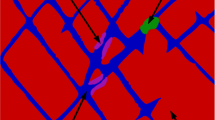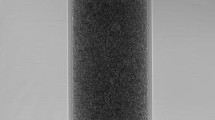Abstract
While low resolution limits the use of computed microtomography for microstructural investigation, the method has a unique advantage in that no specimen preparation is required; the images produced are thus entirely free of specimen preparation artifacts. In the present communication we report examination of the microstructure of a w:c 0.6 mortar, with the tomographic information resolved on a set of more than 500 successive planar images each 1.2 μm apart. Selected images are compared with backscatter SEM images taken from similar materials at comparable magnifications. The same features are observed, including sand grains, air voids, residual cement grains, hydrated cement paste components, and hollow-shell pores. The “patchy” microstructure of different areas of hardened cement paste, previously reported for mortars and concretes in backscatter SEM, is clearly also present in images derived from computed microtomography, and are not artifacts of SEM specimen preparation.
Similar content being viewed by others
References
Flannery BP, Deckman HW, Roberge WG, D’Amico KL (1987) Three-dimensional X-ray microtomography. Science 237:1439–1444
Landis EN, Nagy EN, Keane DT (2003) Microstructure and fracture in three dimensions. Eng Fracture Mech 70:911–925
Landis EN, Nagy EN, Keane DT, Nagy GA (1999) Technique to measure three- dimensional work of fracture of concrete in compression. J Eng Mech 125:599–605
Landis EN, Zhang T, Nagy EN, Nagy G, Franklin WR (2005) Cracking, damage, and fracture in four dimensions. In: Jensen OM (ed.) Proceeding of the Knud Hojgaard conference on advanced cement-based materials—research and teaching, Lyngby, Denmark
Landis EN, Petrell AL (2000) Nagy EN Examination of pore structure and durability issues using three dimensional image analysis of microtomographic data. Concr Sci Eng 2:162–169
Stock SR, Naik NK, Wilkinson AP, Kurtis KE (2002) X-ray microtomography (microCT) of the progression of sulfate attack of cement paste. Cem Concr Res 32:1673–1675
Naik NN, Jupe AC, Stock SR, Wilkinson AP, Lee PL, Kurtis KE (2006) Sulfate attack monitored by micro CT and EDXRD: influence of cement type, water-to-cement ratio, and aggregate. Cem Concr Res 36:144–157
Bentz D, Mizell S, Satterield S, Devaney J, George W, Ketcham P, Graham J, Porterfield J, Quenard D, Valle F, Sallee H (2002) The visible cement data set. J Res Natl Inst; Stand Technol 107:137–148
www.visiblecement.nist.gov/
Helfen L, Dehn F, Mikulik P, Baumbach T (2004) Synchrotron-radiation X-ray tomography: a method for the 3D verification of cement microstructure and its evolution during hydration. In: Bartos PJM, Hughes JJ, Trtik P, Zhu W (eds) Nanotechnology in construction. Royal Society of Chemistry, Cambridge, pp 89–100
Diamond S (2004) The microstructure of cement paste and concrete—a visual primer. Cem Concr Compos 26:919–934
Diamond S (2003) Percolation due to overlapping ITZs in laboratory mortars? A microstructural evaluation. Cem Conc Res 33:949–955
Diamond S (2004) The patchy structure of cement paste in conventional concretes. In: Kovlar K, Marchand J, Mindess S, Weiss J (eds) Concrete science and engineering: a tribute to arnon bentur. RILEM Proceeding. PRO 36, RILEM Publications S.A.R.L, Paris, pp 85–94
Diamond S (2005) The patch microstructure in concrete: effect of mixing time. Cem Concr Res 35:1014–1016
Acknowledgments
The assistance of Dr. Denis Keane in obtaining and resolving the CT microtomography data are acknowledged with thanks. Parts of this research were conducted at the National Synchrotron Light Source, Brookhaven National Laboratory, which is supported by the US Department of Energy, Division of Materials Sciences and Division of Chemical Sciences.
Author information
Authors and Affiliations
Corresponding author
Rights and permissions
About this article
Cite this article
Diamond, S., Landis, E. Microstructural features of a mortar as seen by computed microtomography. Mater Struct 40, 989–993 (2007). https://doi.org/10.1617/s11527-006-9194-9
Received:
Accepted:
Published:
Issue Date:
DOI: https://doi.org/10.1617/s11527-006-9194-9




